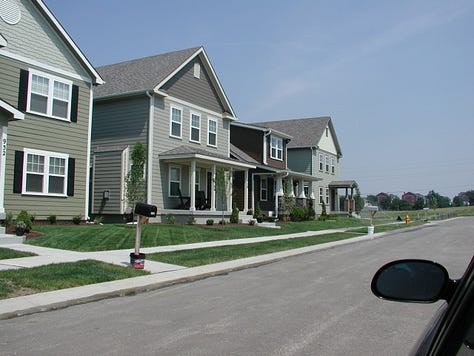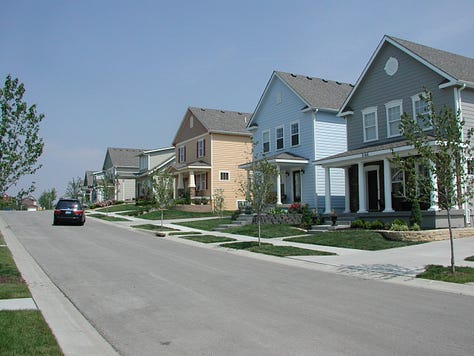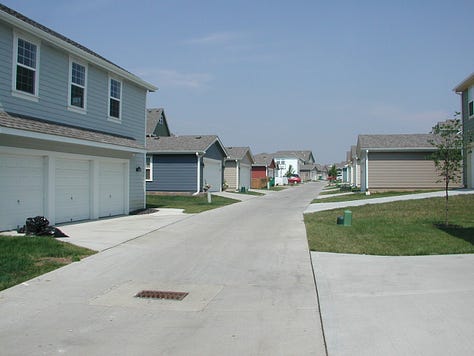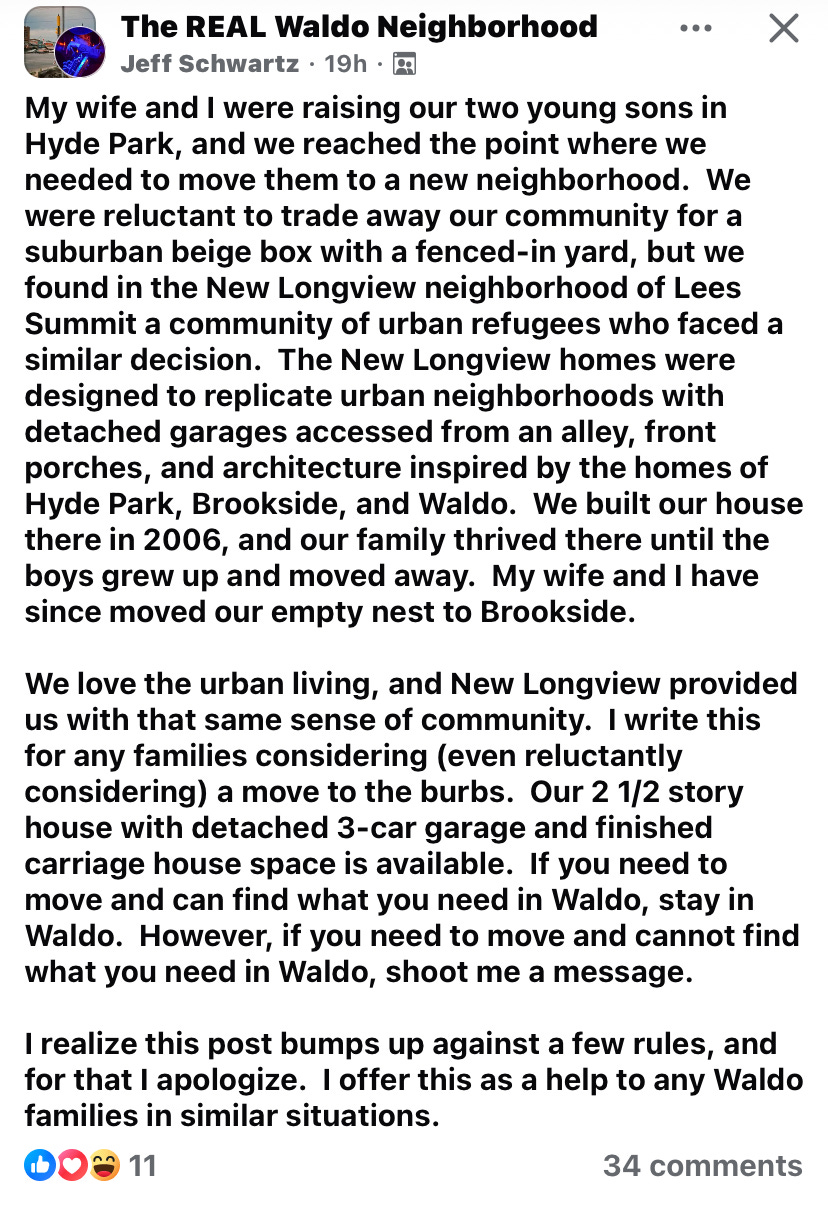Competition Makes Cities Better
Competition within a region is not a problem, it's actually the solution.
Over the weekend, a friend shared a Facebook post with me from a local neighborhood group. Before I get to the post, here’s some context and background.
Back around 2001, I helped master plan a new community called New Longview, in Lee’s Summit, MO. New Longview took the New Urbanist approach to development, which means it’s a walkable community based on designs from neighborhoods built in the 1910s-20s. The most notable local example is one called “Brookside” in Kansas City, MO. The developer, Gale Communities, did really well with the project up until the financial crisis in 2008, and the project now is in the hands of some other developers as it is being completed. But by and large, the first phases are built very authentically to the original vision, and attracted a lot of market interest. In fact, at the initial Parade of Homes for the first phase, in I think 2004 or so, the project set a record for attendance.



New Longview is in a suburb of Kansas City called Lee’s Summit. Lee’s Summit is actually an older historic town on the railroad (it has an Amtrak stop on the line between KC and St Louis), but it’s largely built out as a suburb. The city has exploded in growth the last few decades, and is largely considered a very safe, thriving and successful community.
As a metropolitan region, Kansas City has long had a very typical social and growth pattern for American cities. By that I mean, a lot of young people enjoy living in “the city” until they marry and have kids, and then they move off to the suburbs for schools and better public safety. Over about the last 15 years, that movement has slowed somewhat with the rise of charter schools in the city proper. KCMO has a robust charter school ecosystem, and the popularity of many of the schools has helped keep a lot of young families in the urban core.
But the last five years have seen a more troubling trend, and a notable reversal as we’ve faced a genuine public safety crisis. KCMO has had an explosion in crime of all kinds. For those of a certain age, it reminds us of the late 1980s and early 1990s. I’m not exaggerating when I say it’s been bad. It’s been very bad. And it’s not been just any one thing. It’s been a horrible combination of violent crime, property crime and disorder on the streets. More than a few people have hit a breaking point, and left in spite of their love for the city or their school.
So that’s the context for this Facebook post, which was shared with me over the weekend:
I share all this to make two points, which I think impact cities all over the country, not just Kansas City.
The first is that competition is good. And cities need competition – real competition from new, authentic and walkable places. So many big cities, like mine, have had very stagnant local politics for many years. Major problems just don’t get addressed or addressed well. The City is not managed well, and local elected officials don’t prioritize the basics of good government. The local political machine marches on, regardless of what happens.
They can do this because the City itself has qualities that most suburbs lack, and so it will always attract people. The City has beautiful architecture, streets, public spaces, neighborhood shopping districts you can walk to or ride a bike to, and regional amenities. While the suburbs can’t often recreate those regional amenities, they could certainly do everything else. Without that competition, though, leadership in cities simply gets lackadaisical, and doesn’t strive to fix its core issues. After all, there’s always a certain percentage of people who will keep coming regardless. Why try harder?
Competition from authentic, well-executed walkable places in suburbs would actually help cities prioritize what matters, and manage themselves better. Suburbs are often, though not always, much better managed and focused on 80/20 issues: crime, schools, cleanliness, etc. Suburbs instinctively focus on having family-friendly amenities, since that’s the core demographic. Cities could do this, too, but rarely do. That’s a shame, since walkable, humane cities are far better for children and families than being a personal chauffeur 24/7/365 in places where walking is only for weirdos.
But to create meaningful competition for big cities, we have to address my second point.
I’m amazed how, in 2025, after 40 years of New Urbanism and Traditional Neighborhood Design, so few builders and developers have realized people actually like this stuff. I understand inertia, I understand people don’t like to change what they’re doing. I understand it’s hard to change course on what you’ve been doing for 10, 20, 30 years or more.
But the thing is, people really do like beautiful places that are built around walking, biking and attractive public spaces. Is it everyone? No, of course not. Is it more than the small sample of places currently available to people? Yes, 100% yes. I will go to my grave insisting that the majority of people really like living in more sociable, more humane communities like we built for literally thousands of years.
And unfortunately, too many developers just don’t see the opportunity. Don’t get me wrong - I really like developers. I love the industry. I love people who take risks, who build real things, and who do it every day. This is not a developer-bashing piece. In fact, I’m a developer, too. But there’s groupthink in every line of work, and the naysayers on walkable communities are way too strong within the core world of day-to-day builders and developers in most American communities.
Making our suburbs more walkable, more “traditional” in the broad sense is not just a way to make them more successful. It’s also, ultimately, a way to help our big cities focus better on what matters the most to most people, and make them more successful as well.





This may have been a newer part of the neighborhood where the street trees are not established (or older photos). We moved here in 2022 in the newest part of the New Longview, and the older streets have a mature street tree canopy now - along with an easy walk to the town center (and a movie theater). Showing his trademark humility, Kevin also forgot to mention that the neighborhood preserved an historic working farm. Our block has a nice mix of empty nesters and young families where the kids walk to the elementary school two blocks away - an adaptive reuse of an historic horse barn. The community also has a mix of housing types - including multifamily and a bungalow (cottage) court, in addition to our alley-loaded single-family. I appreciate the great work that Kevin and David Gale did here - not just as an urban planner, but also as a resident!
I'm sorry, I don't mean to be difficult, but other than the front porches and the rear garages, the photographs you have included look like any other soul-sucking suburb I am familiar with. I'm 100% a City girl, and lived and raised my kid in the City - Richmond, Virginia - even when crime was a huge deal. In fact, we were notably the per capita murder capital of the U.S. for a period - YAY us!
- a title facilitated in large part by the crack epidemic, our location on I-95 in between Miami and NYC, and our (still) lax gun laws. And I chose to live in the City when our schools - outside of a few notable elementary schools - sucked. As an aside, they still suck, for the most part.
Is there something I am missing here? I don't hate developers either. I sell real estate for a living. I know there need to be choices. I'd love to see developers build truly new urbanist suburban communities. But that....doesn't look like it.